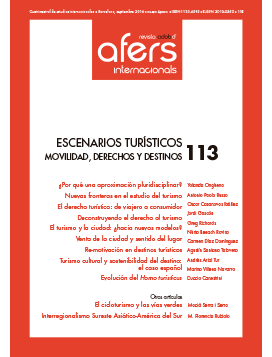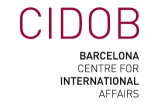The contributions of cultural tourists to the sustainability of destinations: the case of Spain
Keywords:
cultural tourism, probit models, Spain, destination management, sustainabilityAbstract
Revista CIDOB d’Afers Internacionals, nº 113
Quadrimestral (May-September 2016)
ISSN:1133-6595 | E-ISSN:2013-035X
DOI: https://doi.org/10.24241/rcai.2016.113.2.123
Because of the particular characteristics of those who engage in cultural tourism, it is an activity that can contribute to increasing the sustainability of destinations. This article seeks to broaden knowledge in this field in the case of Spain. With this aim, models of probability are applied (probit models) to a sample of international tourists to analyse the factors that improvethe chances of them being cultural tourists in Spain in a period of analysis that corresponds to 2013. The results of the research allow recommendations to be made for a tourism policy in the cultural field that has a vision of the future.
>> The full text articles of this issue are available only in Spanish language
References
ATLAS (Association for Tourism and Leisure Education). ATLAS Cultural Tourism Survey. Report 2007 (en línea) http://www.tram-research.com/atlas/ATLAS%20Cultural%20Tourism%20Survey%202007.PDF , 2007.
Europa Nostra. Cultural Heritage counts for Europe. CHCfE Consortium, Cracovia: International Cultural Centre, 2015.
Hjalager, Anne-Mette y Richards, Greg (eds.). Tourism and Gastronomy. Londres: Routledge, 2002.
IET. Encuesta de Gasto Turístico (EGATUR). Madrid: Instituto de Estudios Turísticos, Ministerio de Industria, Energía y Turismo de España, 2015.
Isaac, Rami. Understanding the Behaviour of Cultural Tourists: towards a classification of Dutch cultural tourists. Breda: NHTV Breda, 2008 (Tesis de doctorado).
McKercher, Bob y du Cros Hilary. Cultural Tourism: The Partnership between Tourism and Cultural Heritage Management. Nueva York: The Haworth Hospitality Press, 2002.
Ministerio de Educación, Cultura y Deporte. Estadística de Museos y Colecciones Museográficas. Madrid: Ministerio de Educación, Cultura y Deporte de España, 2013.
Ministerio de Educación, Cultura y Deporte de España. Anuario de Estadísticas Culturales AEC 2013. Madrid: Ministerio de Educación, Cultura y Deporte de España, 2014.
OCDE (Organización para la Cooperación y el Desarrollo Económicos). The Impact of Culture on Tourism. París: OCDE, 2009.
OCDE (Organización para la Cooperación y el Desarrollo Económicos). Tourism and the Creative Economy. París: OCDE, 2014.
OMT (Organización Mundial de Turismo). World Tourism Organization Annual Report 2015. Madrid: Organización Mundial del Turismo, 2015.
Richards, Greg. Cultural Attractions and European Tourism. Wallingford: CABI, 2001.
Richards, Greg «What is Cultural Tourism?», en: den Hartigh, Edith; van Maaren, Annemieke y Körver, John (eds.). Erfgoed voor Toerisme: een visie van de gezamenlijke erfgoedkoepels op erfgoed en cultuurtoerisme. Amsterdam: Nationaal Contact Monumenten, 2003, p. 29-45.
Richards, Greg. «Creativity and tourism: The state of the art». Annals of Tourism Research, vol. 38, n.º 4 (2011), p. 1.225-1.253.
Richards, Greg. Tourism trends: The convergence of culture and tourism. Breda: NHTV Breda, 2014 (mimeo). Richards, Greg y Palmer, Robert. Eventful Cities: Cultural Management and Urban Revitalisation. Londres: Routledge, 2010.
Richards, Greg y Wilson, Julie. «Developing creativity in tourist experiences: A solution to the serial reproduction of culture?». Tourism Management, vol. 27, n.º 6 (2006), p. 1.408-1.413.
Smith, Melanie y Richards, Greg (eds.). The Routledge Handbook of Cultural Tourism. Nueva York: Routledge, 2013.
Timothy, Dallen J. y Boyd, Stephen William. Heritage Tourism. Londres: Pearson Education, 2003.
Toselli, Claudia. «Algunas reflexiones sobre el Turismo cultural». PASOS Revista de Turismo y Patrimonio Cultural, vol. 4, n.º 2 (2006), p. 175-182.
Wooldridge, Jeffrey M. Econometric Analysis of Cross Section and Panel Data. Cambridge, Mass: The MIT Press, 2010.












